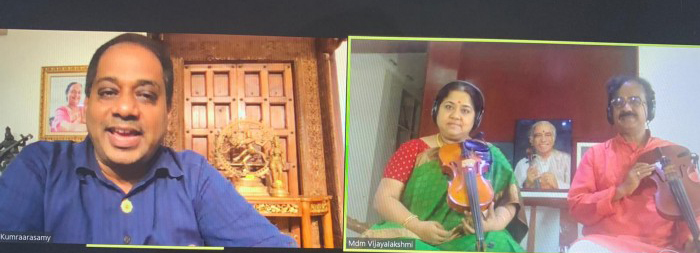
In the penultimate webinar of Dance India Asia Pacific 2020, Lalgudi G J R Krishnan and Lalgudi Vijayalakshmi presented an hour-long live session on Lalgudi’s Thillanas that reinforced not only the ingenuity of legendary maestro, Lalgudi G Jayaraman but also the classic and aimless quality of his compositions that continue to woo, and wow performers and audiences alike across the world. Carrying forward this tradition, the Lalgudi bani, the duo, musicians in their own right and with accolades and awards aplenty, brought to fore the quintessential aspects that add a quality of distinctiveness to the compositions of Lalgudi Jayaraman. “You know, my father was often asked why he composed more of Thillanas and Varnams,” said Vijayalakshmi, “And his response to it was that his inspiration is both the laya and the melodic aspects of music and both these compositional forms allow me ample scope to express these aspects and layer it with my own imagination.”
On a lighter vein, Krishnan spoke about how to a listener a Lalgudi composition may sound like “jalapeño pepper dipped in chocolate” but honestly, he said, “performing any one of his compositions requites a great amount of skill and practice”. Originally a ritualistic composition, credit to give the Thillana a face-lift and pride of place goes entirely to Lalgudi G Jayaraman who created compositions that forced people to “sit up and take notice for the way he wove into it musicality, melody, rhythm, poetry, emotions and the raga bhava, and all so naturally. In his scheme of things, nothing was ever contrived,” Krishnan said.
On this day, dancers continue to dance to the compositions of Lalgudi Jayaraman and the duo spoke about how he used the concept of space in music almost like a dancer — “like the way, a dancer uses space on stage, you can see the concept of space in his music,” Vijayalakshmi said speaking also about he uses phrases intelligently and also one that defined the very essence of the ragam itself.
Flamboyant in its very form and appeal, Lalgudi’s Thillanas are true embodiments of the idea of the marriage of contrasts — strength and beauty, melody and mathematics, aesthetics and freedom and restraint. “I see in his compositions, a poet, a painter, a sculptor, an architect,” Vijayalakshmi said, “He knew the colour of the notes, he used phrases like a poet, approached the laya like a sculptor and an architect and built an aesthetic edifice using them all.
Quoting an example, Krishnan spoke about the popular Thillana in ragam Mohanakalyani, and talked about how when he plays it, his father almost imagined it like a deer that ran up a mountain and stopped every now and then, to look back and assess its course before it began jumping and running up the mountain. Or the Madhuvanthi Thillana, it’s almost like leaves falling down with a gentle sway and when you place the notes, it’s like you can see the leaves falling.”
As a constant seeker, innovation was at the core of his compositions. Just like a dancer creates sancharis, his music too, they said, danced and had sancharis of its own. “There is in his music, an invisible continuum of its own,” Krishnan said. Here’s a little excerpt on his concept of Sruthi Bedham
The lec-dem was also packed with anecdotes aplenty. Vijayalakshmi spoke about a story where when she was in college, her friend, dancer Sujatha Srinivasan evinced interest to perform her father’s composition in Kaanada. “I knew this was one of the compositions that was a part of the 8 Thillanas for Dance of Sound and I also knew my father hadn’t penned the lyrics yet. But when I put forth the request to him on behalf of my friend and suggested he could use the flower and the moon in the poetry, I remember how he beautifully did that and in hindsight, every time I think or perform this Thillana, it’s impossible to think or believe that the lyrics came after the composition was already set.
To be a genius, is to be inspired and no one better than Lalgudi G Jayaraman who lives his life in a state of “being inspired”. The amazing thing about him, the duo said, was that he was so generous and equally inspired by a child as he was by a well-know dancer. It is a state we all seek and perhaps humility, empathy and sensitivity are amongst lessons wee can learn to appreciate from geniuses that created and whose compositions we continue to dance to; some literally dance, some others, like us who don’t dance on stage, let it dance in our minds!
Up next is a conversation between dancers, Priaydarsini Govind and Shobana at 8pm (SGT)









